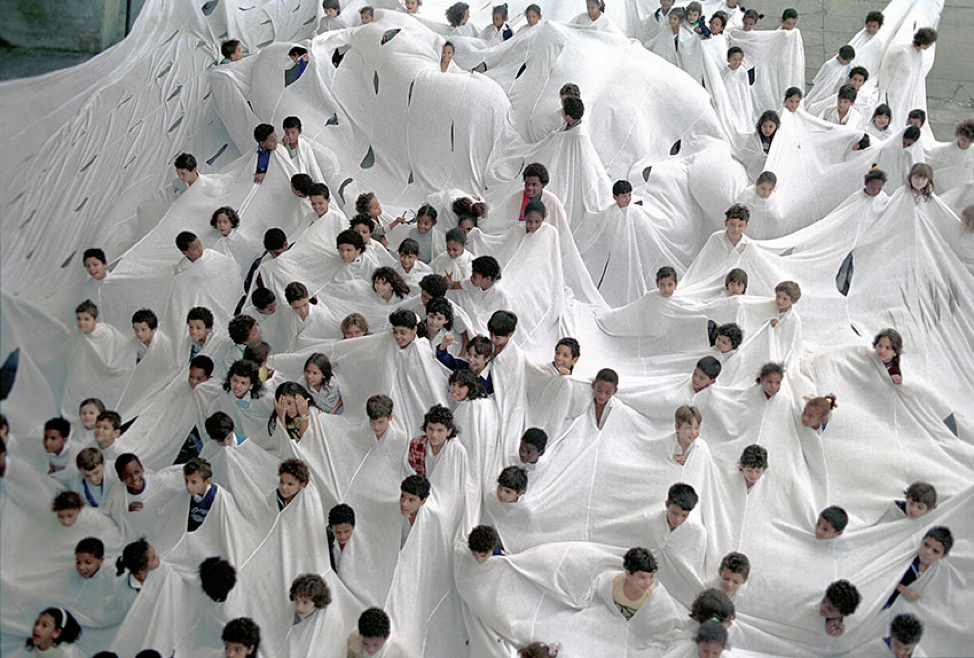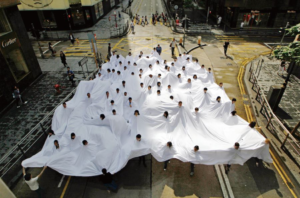
How Can We Keep the Love of Teaching? Waking up and Positioning Ourselves
As we finish this semester, it might be a good exercise to look back and see what worked, what didn’t quite work, and what will never work. Student evaluations often convey needs or anger or unfocused frustrations; very little that can actually teach us, so we must ponder our own little achievements and many frustrations. At each semester’s end, it would do us good to ponder what a classroom might be and what we can do in that environment in relation to the larger social-political arena we live in now.
In a short excerpt from an interview,[1] Gilles Deleuze speaks about the classroom less in terms of mediating processes of apprehension and comprehension, and more in terms of movements and processes of becoming. He contends: “A class does not have as its sole objective total comprehension [of a subject matter] . . . A class is an emotion . . . It is not a matter of understanding and absorbing everything. It is a matter of awakening in time to capture that which is meaningful [to our own realities].” In his Difference and Repetition, Deleuze speaks of experiences that force us to awaken, to feel, not merely to comprehend something novel: “this something is an object not of recognition but a fundamental encounter,” he writes.[2] The arts are capable of generating such encounters—they undo the seams of our limitations, habitual circumstances, belief systems, values, and knowledge to weave the invisible back into the perceptible. Beyond a representation of subjects, facts, history, data, encountering art affectively allows us to sense and not cling to the world as it is but to imagine it more expansively, with further potential becomings. As such, the arts require the totality of our beings-in-bodies to be present and to co-create our realities anew—whether in classrooms, art galleries, the streets, or in the intimacy of our closest communities.
Artistic manifestations often allow us to access and connect, individually and collectively, with what is meaningful, potentially generative, and ultimately transformative. It is less about fully understanding the world as such and more about being alert to discover the opportunities that this world offers us. For that to unfold, we must rise, we must awaken! We must be willing to co-participate in this unfolding. There is no room for passive observation here. We must be willing to move from dormant complacency into the position of co-creators, conjuring up new possibilities of being. Julia Kristeva describes this aesthetic awakening with a reminder that our bodies must take part in the experience with art not only to contemplate the art object but also to sense it. She writes: “The ultimate aim of art is perhaps what was formerly celebrated under the term of incarnation. I mean by that a wish to make us feel a real experience [in the body]” through lines, colors, sensations, abstraction, volume, textures, and participation.[3]
The arts are poised with the power to remind us to celebrate our body-realities. As Mayra Rivera puts it, works of the imagination allow us to move beyond the limits of our earthly flesh and encounter God as we strive to transform this world. Seeing and touching and moving and speaking and feeling is participation in theopoetics—an articulation of the character of God understood through our embodied, affective experiences.[4]

Brazilian visual artist Lygia Pape’s performance piece entitled Divisor (1968) does just that: it probes the limits of our sensorial and psychological conditions, relying heavily on the physical, embodied, affective, and—most importantly—collective participation of viewers. Divisor is at once performance and sculpture, interweaving bodies of spectators/participators, physical space, mobility, and artwork in a literally moving piece.[5] Originally performed in the city of Rio de Janeiro in 1968, this performance was re-enacted in the streets of New York on March 26th, 2017, in collaboration with the Metropolitan Museum of Art.[6]
Comprised of a 30-meter, white cotton fabric in the shape of a square, the piece has two hundred holes symmetrically perforated in the fabric through which viewers are invited to “wear” the sculpture, so to speak. Once 200 co-participators and co-creators are properly positioned, they are invited to enact a procession while wearing the artwork. Pape’s white fabric reposed over the shoulders of the participants, isolating the rest of the body, allows a commanding procession to take place. The effect is both poignant and powerful: a multitude of differently “bodied” people, unified by what takes on the shape of undulating waves, moves through the public arena in a procession. Their movement transmutes precariousness into potency. The work of art highlights the simultaneity of the shared life of those present: their bodies both tied to one another and acting upon one another, are transformed by one another. Such “imbrication of bodies in the fabric of the world,” as Rivera puts it, facilitates a union of sorts.
What works of art such as this require of us is an awakened presence that is able to move forward in solidarity, entanglement, capacious resistance, and, most importantly, with response-ability, to borrow Catherine Keller’s language.

How can we teachers conjure up opportunities in our classrooms that resemble the communal potency of Divisor? As the semester draws to a close and we reflect on strategies for learning and teaching and living, we ask ourselves: how can we wake that which is dormant inside of us? If another reality is possible, how can we work towards its actualization? How can we even keep the love of teaching when our very schools are crumbling down? How can our very understanding of education continue to produce a teaching-wonder and teaching-resistance that is so fundamental to the fullness of our lives and our communities?
Knowing the dazzling possibilities of education and the dangers entailed in it, we are required to place the practice and the thinking of education in relation to the structures of our time. And we don’t live in the easiest times. Educators are rapidly becoming dispensable people who are supposed to teach whatever it is that has no critical engagement. In Brazil, for instance, a growing number of people are calling Paulo Freire to disappear from curricula. He is accused of being an ideologue, a communist whose education project aims only to destroy the values of family and country. Just recently, Judith Butler was almost physically attacked at the Sāo Paulo airport by a Brazilian woman who saw in Butler’s feminist and queer theories a threat to what she understood as the “traditional” Brazilian family.
In the US, education, like health insurance, religion, among a great number of other things, has come to be understood as a private value dependent on individual efforts. Having been taken hostage by neoliberal systems, education must “produce” something, preferably at a profit. In this model, students must be treated like customers—education is less about formation than production, like an assembly line. The assaults by the Department of Education, the constant push to make education a matter of corporate profit and endless student debt, the targeting of colleges as a bad thing for the life of the country, the cutting of educational budgets for the sake of “austerity plans,” the creation of prison systems, the loads of money the Koch Brothers injected into higher education, the Senate Tax Bill that was passed recently, all form a narrative worthy of Dante’s Inferno. If education should only serve to produce people to fulfill the lines of jobs, the endless testing and precise measurements of syllabi begins to make sense. No wonder many of us in the classrooms have become apathetic and anesthetized.
If one was able to go to AAR this last November and paid attention to the conversations that happened in between the academic sessions, you would know that the plight of so many educators is dire. I heard a professor saying to a friend at the exhibition hall: “I have been battling for 3 years now and I can’t continue doing adjunct jobs. This is my last year trying to find a job, or I will have to find something else to do. I can’t keep living this way, I have a family.”
If the classroom and school bring daily struggles, embarrassment, precariousness, and even humiliation to our colleagues, how are we to keep our love of teaching? It is easy for me Cláudio to say, let us keep on loving our teaching and do it the best way we can. But I have a good job with great colleagues. Yohana who co-writes this blog post is a Ph.D. candidate. Will she ever find a good job?
We need to engage our profession with a more critical sense of what it means to us, and how it can be made more expansive and sustaining. How can we support and accompany our colleagues who contest the violence of a plutocratic state, the erosion of our communities, the criminalization of protest, rising poverty, constant blaming of the poor, debt, emotional and physical exhaustion of those who are poor?
There are no easy answers. There were never any easy answers. Perhaps we can start by thinking that our classrooms are places where we can still be awakened, that every time we meet we can raise up what was dormant in us. Perhaps we can discover that we need to pay attention to our emotions, our bodies, the communities that are formed in each classroom. Perhaps we ought to find better and more sustainable technologies of self and communal awareness, or spiritual practices that can become resources for our constant battle against the empire and its neoliberal systems. Perhaps we can also see our gift to teach as a way of positioning ourselves: first within ourselves, and then as a way of positioning ourselves in the world. Perhaps . . . .
[1] https://www.youtube.com/watch?v=-ln2A0fkA78
[2] Gilles Deleuze, Difference and Repetition, trans. P. Patton, (New York: Columbia University Press, 1994), 139.
[3] As quoted in Stephen Bann, “Three Images for Kristeva: From Bellini to Proust,” in Parallax, 1998, vol. 4, no. 3, 64–65.
[4] You can see more of this articulation in Rubem Alve’s work.
[5] Fernanda Pequeno, Lygia Pape e Helio Oiticica: Conversações e Fricções Poéticas (Rio de Janeiro: Editora Apicuri, 2013).
[6] Metropolitan Museum of Art
*Blog Originally Published on December 14, 2017
Leave a Reply